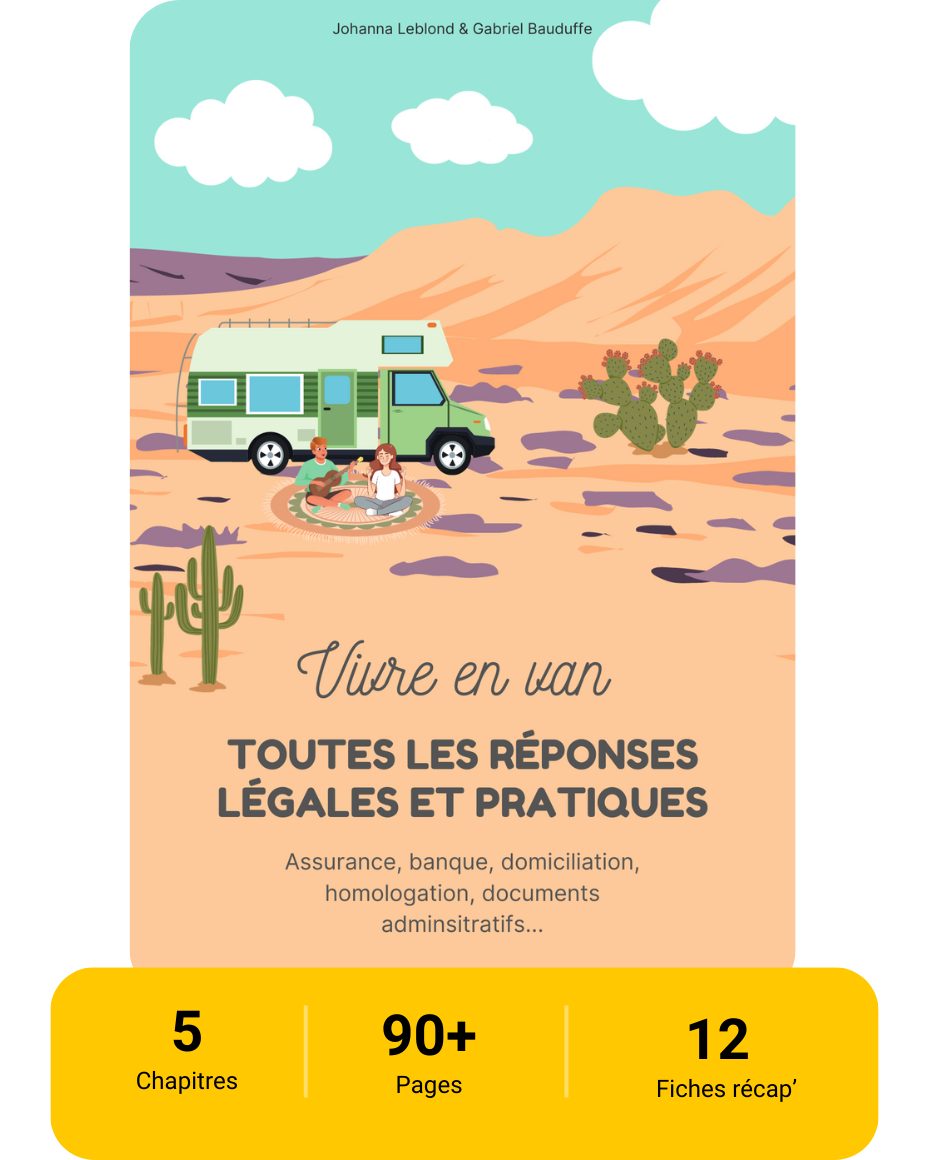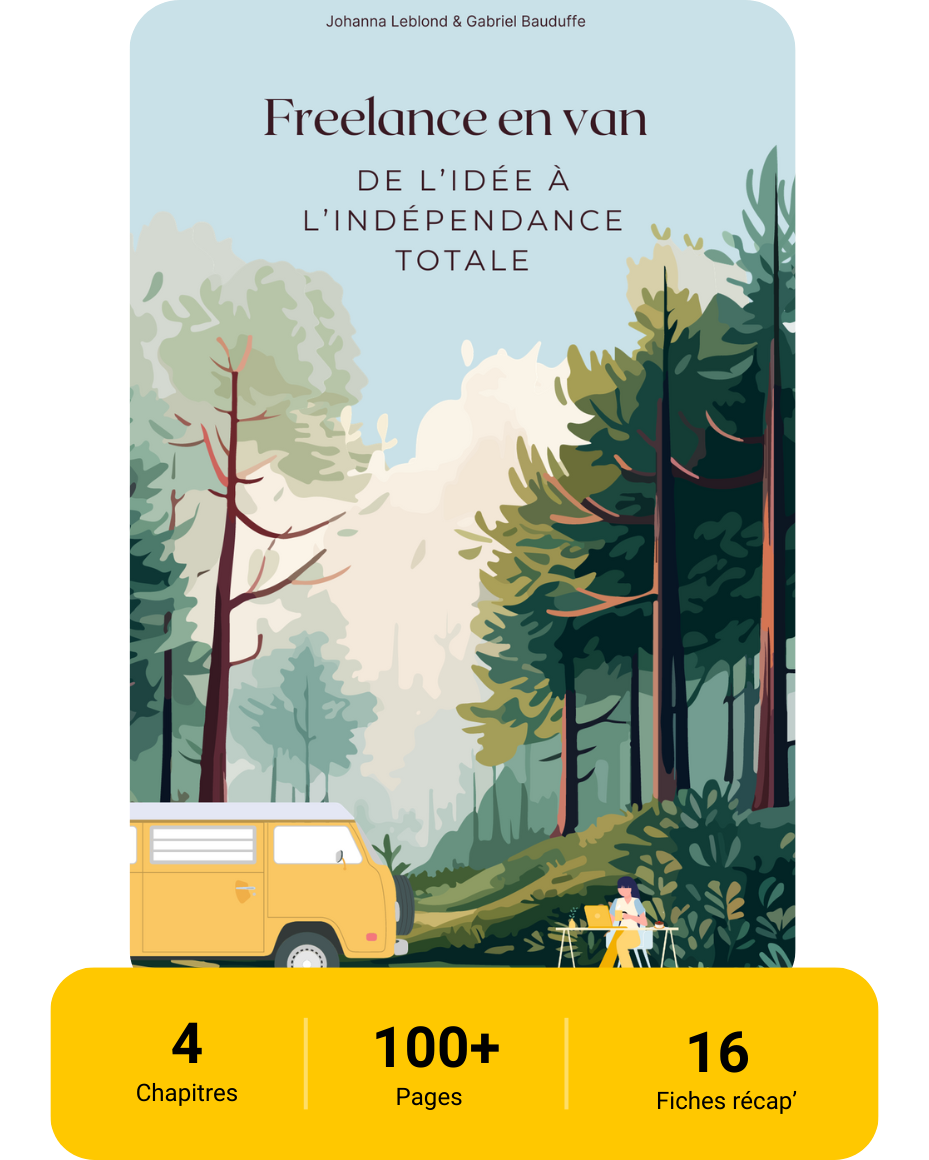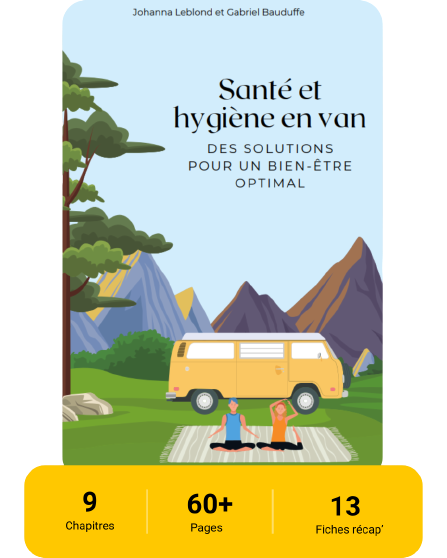After running a poll on Instagram and Twitter, we found that the average van conversion cost is around €6,000.
That figure is based on answers shared by members of our community.
Some people managed to convert their van for less than €3,000, while others spent over €20,000! 😮
As you can see, the price range is pretty wide.
And if you don’t already own a van, keep in mind you’ll also need to factor in the cost of the vehicle itself:
- A brand-new empty van designed for leisure can range between €20,000 and €120,000.
- A used empty van, on the other hand, can cost anywhere from €1,000 to €20,000.
When you’re just starting out with van life, your van conversion cost will depend on the type and size of your van—but even more importantly, on your needs and expectations.
Here’s a general idea of what to expect in terms of expenses:
- Van purchase: €1,000 to €120,000
- Insulation: €100 to €3,000
- Flooring and wall covering: Around €1,000
- Windows and ventilation: €150 to €1,500
- Water system: €150 to €500
- Bed setup: €150 to €600
- Bathroom: €20 to €200
- Kitchen: €500 to €2,000
- Interior decor and finishing touches: €50 to €200
In the rest of this article, we’ll take a closer look at each of these categories to help you get a realistic idea of how much your camper build might cost.
By the end, you should be able to create your own van conversion budget based on your priorities and preferences.
💡 And if you’re still unsure how to finance the purchase, build, and lifestyle—don’t miss our guide: 13 smart ways to fund your vanlife dream.
Buying a Van: Should You Go for New or Used?
In most cases, buying the van itself will be your biggest expense.
We know this decision can feel overwhelming—we get messages about it all the time from readers just like you.
And honestly, it’s not a simple choice. After all, this won’t just be a vehicle… it’ll be your home on wheels once it’s fully converted.
So, your van needs to match your lifestyle and your practical needs. Here are a few important things to think about before making a decision:
- Interior height
- Length of the vehicle
- Exterior color (yes, that matters for staying stealthy!)
- Mechanical reliability (engine, transmission, overall driving experience)
- Year of manufacture
- Horsepower
- And more…
Once you’ve outlined your priorities, ask yourself the big question 👉 Should you buy a used van or go for something brand new?
Buying a Used Van
Opting for an older, second-hand van can help you cut down your overall van conversion cost. But keep in mind—used vehicles are usually less reliable mechanically.
This option might be right for you if:
- You’re comfortable with basic mechanics or have some savings set aside for garage repairs;
- You don’t plan on driving through low-emission zones (many older vehicles are now restricted in these areas, and the regulations are expanding fast);
- You don’t intend to drive long distances every year (think 15,000 to 20,000 km/year, or about 9,000 to 12,000 miles).
Buying a New Van
Going for a brand-new van will obviously cost more upfront.
But in exchange, you’ll get a more fuel-efficient and mechanically reliable vehicle, which means fewer surprises and less money spent on maintenance in the long run.
It also saves you from a lot of stress—especially if you’re new to van life or planning long-term travel.
(That said… we’ve still seen a few lemons out there. So always double-check before buying 😉)
Buying a brand-new van isn’t always the best choice—just like buying used isn’t automatically better either. It really depends on your situation and your priorities. That’s why we always recommend doing your research before making a decision.
Keep an open mind about both options. If you stay flexible, the right opportunity will likely show up when you least expect it.
The goal is to find a camper van that truly fits your lifestyle—without eating into the budget you’ve set aside for the actual conversion.
If needed, don’t hesitate to ask a friend or family member who knows about vehicles to help you out.
And whatever you do… don’t make the same mistake we did—don’t buy on a whim! 😅
👉 Want to go deeper? Check out our full guide to help you choose the right van for your conversion project.
Van Purchase Cost Overview
- New van: €20,000 to €120,000
- Used van: €1,000 to €20,000
Van Conversion Cost: Budgeting for Insulation (€100 to €3,000)

Will you be living in your van full-time, or just using it for weekends and vacations?
Do you plan to travel in warm, dry regions—or will you be spending time in cold, rainy, or humid environments?
Your answers to these questions will determine how much insulation you need, and ultimately, how much this part of your van conversion cost will be.
For example, if you’re heading into colder climates, you’ll need multiple layers of quality insulation materials to keep things warm and dry.
If you’re only planning to use your van in the summer, you can go for a lighter, more affordable insulation setup.
That said, insulation isn’t just about cold—it can also help protect you from the heat. Some eco-friendly options include recycled cotton, hemp, wood wool, cork, or cellulose.
Insulation is also key to managing humidity inside the van. It helps prevent rust and mold, two major enemies of van life.
Before setting your insulation budget, remember that you’ll need to insulate:
- The walls
- The roof
- The floor
- Any exposed pipes (to prevent freezing damage)
Van Insulation Cost Breakdown
- Expanded cork: €400 to €600
- Biofib Trio (requires pairing with another material): €400 to €600
- Sprayed cork insulation: €1,200 to €2,000
- Hemp wool: €400 to €700
Depending on your needs and travel plans, you can usually insulate your van for around €500.
That said, keep in mind that insulation is not reusable. If you switch vehicles later, you won’t be able to take it with you—so take the time to plan it out carefully!
As a side note—when we bought Hermès, our beloved camper van, the insulation had already been done.
It’s not the most efficient setup anymore, but we decided not to replace it.
Why? Because our van is quite old, and we figured it wouldn’t make sense to invest in upgrades we couldn’t reuse or transfer to another vehicle.
Instead, we chose a more practical (and cozy) solution: warm clothes, blankets, a good heater… and a positive attitude 😜
Van Wall, Ceiling & Floor Cladding (Approx. €1,000)
Another important part of your van conversion cost is the interior cladding.
You’ll need materials to cover:
- The walls
- The ceiling
- And the floor
Just like with insulation, this step deserves careful planning—because once installed, you can’t really reuse these materials in another build.
💰 On average, expect to spend around €1,000 for cladding.
(Some vanlifers manage to spend less, depending on the materials they choose and what they can salvage.)
However, be aware: rising material prices—especially for wood—can significantly affect your van build budget. In recent years, wood prices have increased by 30% to 110%, depending on the type.
The good news? Your choice of materials gives you full control over the style and ambiance of your van. Whether you’re into a minimalist, modern vibe, or something rustic and cozy, it all starts with the cladding.
There are plenty of material options to choose from—and we’ll explore some of them below.
Materials for Walls and Ceiling
- Plywood: Durable and easy to install, but on the pricey side
- Wood paneling (tongue and groove): Easy to install and budget-friendly, but heavy if used throughout the van
- Seagrass matting: Affordable and eco-friendly, but tricky to install and prone to mold in humid conditions
Materials for the Floor
- Solid wood flooring: A beautiful option, but expensive
- Peel-and-stick vinyl planks: Easy to install and budget-friendly
- Carpet: Comfortable and easy to lay down, but tough to keep clean on the road
Windows and Ventilation (€150 – €1,500)
To protect your camper van from humidity, mold, and rust, there are two key elements to consider:
- Insulation
- … and ventilation
If you’re planning to get your van registered as a certified camper (VASP in France), you’ll need to follow specific safety standards—like the NF EN 721 regulation.
This standard requires you to install both high and low air vents, with specific dimensions based on your van size and the equipment you’re using.
These upgrades are part of your overall van conversion cost, whether you handle them yourself or hire a pro.
Here are some typical ventilation-related expenses:
- Roof vent (fan or skylight): €50 to €400
- Air vent grilles: €5 to €20 each, depending on size and quality
💡 If your van doesn’t get much natural light, you might also consider installing windows.
Cutting through the metal body can feel intimidating, but doing it yourself can save you quite a bit—expect to pay €80 to €350 per window, depending on size and quality.
Van Conversion Cost: Building the Water System (€150 to €500)
Installing a water system in your camper van is a game changer—it allows you to do the dishes, cook, and even take showers.
The simplest setup? Connect both your sink and shower to a single water tank.
That’s exactly what we have in Hermès, and honestly—it works great!
💧 If you have a bit more budget, you can add a 12V water pump to improve water pressure (€20 to €150).
And for those who want even more comfort, you can install a water heater—but be warned, it can take a big bite out of your van conversion budget.
Then again… who wouldn’t splurge a little for a hot shower on the road? 😄
Just remember: in van life, comfort is what really drives up the cost.
We still remember our very first road trip in a basic converted car.
We met a couple traveling in a nearly empty cargo van—with nothing but a mattress on wooden pallets and a jug of water. And they were loving it.
Water System Cost Breakdown
- Fresh water tank: €30 to €70
- Grey water tank: €30 to €70
- Hoses and fittings: Around €50
- Water pump: €20 to €150
- Water heater element: €20 to €100
- Full water heater system: €200 to €600
Van Conversion Cost: Installing a Power System (€700 to €3,000)
Chances are, you travel with a smartphone—and maybe also a camera, a laptop, or an e-reader.
These devices all need regular charging, and their batteries don’t last forever.
If you plan to use high-consumption appliances like a hair dryer or microwave, you’ll need a more advanced (and expensive) electrical setup.
But if your goal is simply to charge your phone and power a few lights, a basic system can totally do the job—and save you money.
Let’s be honest: electricity is essential to modern van life.
It’s hard to live without it, especially if you want to work remotely as a digital nomad. 😉
The good news? With the exception of the cables (which must be cut to fit your setup), most components can be reused if you switch vans in the future.
So don’t hesitate to invest in a reliable, efficient power system—it’ll be worth it in the long run.
Solar Electrical System Cost Breakdown
- Auxiliary battery: €150 to €700
- Solar panel: €150 to €600
- Inverter: €150 to €400
- Charge controller (MPPT): €20 to €200
- Fuses: Around €40
- Switch: €5
- Lighting: €10 to €30
- Wiring and cables: Around €100
An Easy Alternative: The Solar Generator for RV Living
If you’re not a fan of wiring and complex installations, you can also invest in a solar generator for RV use.
Technically, the term « generator » is a bit misleading—it doesn’t actually generate power, but rather stores and converts solar energy.

That said, a solar generator includes all the key components of an electrical system in one compact, portable box. It’s a perfect solution if you want something plug-and-play with minimal DIY.
We personally recommend the Bluetti EB3A. With 600W of output power, it’s not enough to run a microwave, but it can easily handle 90% of the everyday devices you’d use on the road.
It comes with a 268Wh battery, which might be a bit limited if you’re working remotely full-time.
In that case, you might want to upgrade to a larger model—something like the 716Wh version for more autonomy.
👉 Related article: Best Portable Solar Generators for Your Camper Van – Full Comparison Guide
Camper Van Bed Cost (€150 to €600)

In any camper van, the bed is one of the most important features.
It takes up a lot of space—and let’s be honest, you’ll be spending quite a bit of time there. 😊
So it totally makes sense to set aside a solid part of your budget for this piece.
The good news? Building the bed structure itself doesn’t have to be expensive.
We suggest starting with some inspiration—read this article, watch a few YouTube tutorials, buy your materials, and get building!
💡 That said, there’s one thing you definitely shouldn’t try to save money on: the mattress.
A quality mattress means better sleep and fewer back problems—trust us, it’s worth the investment.
Camper Van Bed Cost Breakdown
- Wood battens: Around €6 per meter
- Slatted bed base: €30
- Metal brackets: Less than €1 each
- Plywood sheets: €30 to €100
- Mattress: €60 to €300
- 2 pillows: €20
- Blanket + sleeping bag: €60 to €200
Camper Van Bathroom Setup: What Does It Cost? (€20 to €200)
In most cases, the bathroom area isn’t a major expense in your van conversion budget.
(Of course, as always—it depends on how much comfort you’re aiming for!) 😊
Our Setup in Hermès, Our Camper Van
In our van, we have a shower tray built into the floor, hidden under a hatch.
When it’s time to shower, we simply lift the hatch, hang a curtain from the ceiling, and pull the faucet from our sink over to the shower area.
The shower tray is connected directly to our grey water tank.
As for the toilet, we use a simple bucket filled with wood shavings, topped with a toilet seat.
Our bathroom setup is as basic as it gets—and it works just fine for us!
Basic Shower Setup Cost Breakdown
- Shower tray: €50 to €100
- Pipes and fittings: Around €150 (unless you’re using the same plumbing as your sink)
- Shower curtain rod: €10 to €100, depending on the shape and design.
Ours is DIY and made from salvaged parts—so it cost us basically €0 - Shower curtain: €10 to €50
- And more…
💡 If you’re looking for more comfort and decide to install a full-time shower and toilet, your costs will go up.
More comfort means more materials, and that means a higher van conversion cost overall.
Van Kitchen Setup Cost

If your van conversion budget is tight and you’re still figuring out your actual needs, start simple.
Grab a portable gas stove to heat your meals, one or two 20L water containers for clean water storage, and invest in a small sink with some basic plumbing to drain your grey water into a waste tank.
👀 In our opinion, if you’re not too picky, the kitchen is where you can save the most money. But of course—that’s totally up to you.
After spending a few days in your van, you’ll quickly realize what you really need… and what you can live without.
Van Kitchen Installation Cost Breakdown
- Fixed cooktop: €150 to €300
- Fridge: €250 to €800
- Oven: €50 to €300
- Storage units: €50 to €100
- Sink, faucet, and plumbing: Around €150
- And more…
Camper Van Decoration Cost (€50 to €200)

While it’s totally optional, decorating your van adds a personal touch and helps create the perfect vibe for your tiny home on wheels.
A space that reflects your style will instantly feel more like home.
Maybe you’ll want to add:
- String lights
- Lanterns
- A mirror
- Decorative baskets (make sure to pick the right size if you shop online!)
- Plants
- Hanging decorations
- Candles
- Throw pillows
- Paint or wall art
- And more…
🪴 Expect to spend anywhere from €20 to €200 depending on how much you want to customize your space.
Need inspiration? Pinterest is your best friend when it comes to van decor ideas!
👉 Check out our 10 Best Van Decor Tips to Style Your Camper Like a Pro!
Bonus: Hidden Costs You Might Not Expect
When calculating your van conversion cost, there are plenty of unexpected expenses that can sneak into your budget—on top of the major categories we’ve already covered.
Van Maintenance Costs (€400 to €1,000)
If you went for a used van, there’s a good chance you’ll need to do some repairs before hitting the road.
On average, a basic service costs around €400.
But if any issues are found during the inspection, the total can easily exceed €1,000.
For example, when we bought Hermès, we noticed an oil leak. Turns out, several gaskets needed replacing.
Our mechanic also discovered that the alternator was on its last legs.
💸 Final bill: €1,145.
Before setting off, make sure to check or have checked:
- Tires
- Seals and gaskets
- Brakes
- Windshield wipers
- Air conditioning
- Lights
- All fluid levels: engine oil, windshield washer, brake fluid, power steering fluid, coolant, and transmission fluid.
👉 Related article: Buying a Van from a Private Seller – How to Avoid Common Pitfalls
Essential Tools for Your Van Build (€100 to €400)

If this is your first van conversion and you’re not used to DIY projects, chances are you don’t have all the tools you’ll need.
You’ve got three options:
- Buy
- Rent
- Borrow from friends or family
Let’s be honest—the last one is the best… because it’s free 😉.
Here’s a rough list of the tools you’ll likely need:
- Drill: €80
- Jigsaw: €50
- Hand saw: €20
- Super glue: €10
- Duct tape: €5
- Pliers: €20
- Screwdriver set: €20
- Screws and hardware: €100
- Wrench set: €35
- Hammer: €10
- Bubble level: €10
- Copper pipe cutter: €20
How Much Does a Professional Van Conversion Cost?
Maybe you’re short on time, nervous about doing it yourself, or simply want a safer setup.
In that case, you can always hire a professional van converter—even if it’s not the most budget-friendly option.
In France and many other countries, there are countless craftspeople and companies specializing in custom van builds.
Since the price depends on the converter, the type of vehicle, and the level of customization, it’s impossible to give an exact average.
But to give you a rough idea, expect to pay anywhere from €7,000 to €50,000 for a professional build.
👉 Related article: Why Hire a Professional Van Builder? Pros, Cons, and Practical Advice
How to Save Money on Your Van Conversion Cost
A van isn’t just expensive to build—it also comes with ongoing costs: breakdowns, repairs, electrical or plumbing issues…
These are all expenses you’ll want to plan for. And the best way to do that is…
🥁 …you guessed it…
Save money where you can!
Especially during the buying and building phases—there are a few simple tricks that can really make a difference.
Let’s dive into some smart ways to cut costs without cutting corners.
👉 Related article: 8 Tips to Save Money on Your Van Build
Buy Second-Hand on eBay or Leboncoin
You can save hundreds of euros by shopping for second-hand items on platforms like eBay or Leboncoin.
You’ll often find fridges, heaters, and other appliances just waiting for a second life in your van.
And that’s not all—you can also score some great decor pieces to personalize your interior without breaking the bank.
Do It All Yourself

It might seem obvious, but doing everything yourself means you skip the cost of hiring professionals.
A DIY van conversion takes time, sure—but it can save you €15,000 or even more!
And beyond saving money, building everything on your own means you’ll know exactly how your system works—super useful if something breaks down on the road.
👉 Related article: DIY Desert Fridge – Step-by-Step Tutorial to Build Your Own Eco Cooler
Think Reuse
We can’t say it enough—converting a van is an amazing adventure.
But as we’ve seen, it also comes with a price.
You should expect to spend around €6,000 on average, plus the cost of the vehicle.
And this might not be your only van build.
You may want to switch vehicles in a few months or a few years.
That’s why it’s smart to plan your build in a way that allows you to reuse as many components as possible for your next project:
- Solar panel and most of your electrical system
- Fresh and grey water tanks
- Cooktop
- Faucet
- Water pump
- Screws and hardware
- …
With this approach, when it’s time for your next build, you might only need to spend around €1,600—instead of starting from scratch!
We hope this guide gave you some helpful insights to better plan the purchase and conversion of your camper van!
If you have any questions about the van build process, feel free to drop them in the comments below—we’d love to help.
👉 Want to go even further? Check out our Van Life Budget Calculator to estimate your monthly and yearly expenses on the road!






0 commentaires